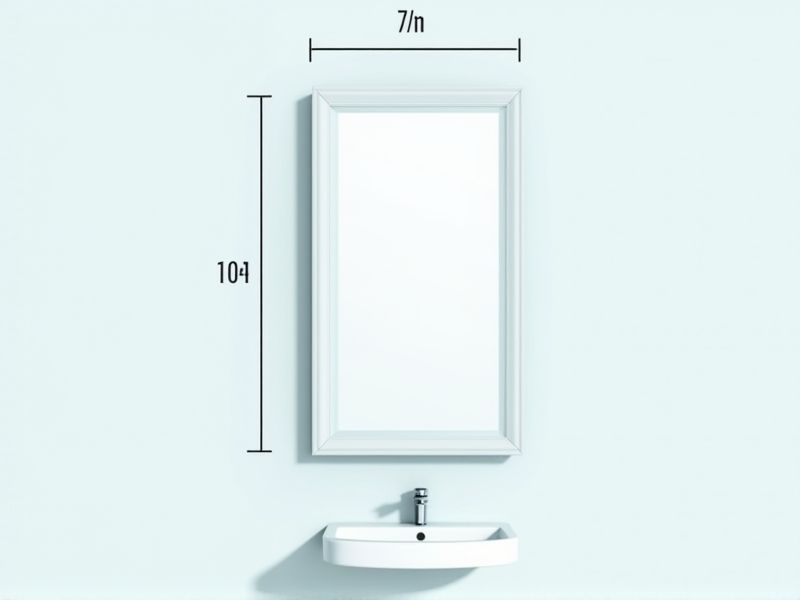
When selecting a bathroom mirror, it's helpful to know the standard dimensions for a balanced and functional look. Most bathroom mirrors typically range in width from 20 to 36 inches and in height from 24 to 36 inches. For example, a mirror that is 24 inches wide and 30 inches high works well above a single-sink vanity. Choosing a mirror that's about 2 to 4 inches narrower than your vanity ensures a visually pleasing fit and provides enough space for mounting lights or accessories.
Width Relative To Vanity
The standard width for a bathroom mirror typically aligns with the vanity size, enhancing both functionality and aesthetics. For a single sink vanity, mirrors are often recommended to be between 24 to 36 inches wide, providing ample reflection space while maintaining visual balance. In contrast, a double sink vanity usually accommodates mirrors ranging from 60 to 72 inches wide, ensuring both sides are well-lit and usable. Choosing a mirror width that closely matches your vanity helps create a cohesive look in your bathroom, maximizing both style and convenience.
Height Above Sink
The ideal height for a bathroom mirror is typically between 50 to 65 inches above the floor, aligning it with user comfort and functionality. For standard sinks, positioning the mirror about 5 to 10 inches above the top edge of the sink is recommended to ensure visibility without obstructions. If you are taller or shorter than average, adjusting the height accordingly can enhance everyday usability. A properly placed mirror not only provides practical use but also enhances the overall aesthetic of your bathroom space.
Edge Clearance
When selecting a bathroom mirror, edge clearance is a critical factor to consider for both functionality and safety. The recommended edge clearance for a mirror typically ranges from 1 to 2 inches from any adjacent fixtures to prevent accidental bumps and ensure proper cleaning access. For optimal design, maintaining a clear space of at least 24 inches above sink height enhances usability and visual appeal. Proper edge clearance not only improves the aesthetic appeal of your bathroom but also contributes to a more comfortable and safe environment.
Mirror Thickness
The standard bathroom mirror thickness typically ranges from 5 mm to 6 mm, providing a balance between durability and functionality. A thicker mirror, such as those with 6 mm thickness, can offer enhanced resilience against breakage and warping over time. Standard sizes for these mirrors usually vary from 24 inches to 72 inches in width, accommodating various bathroom layouts. Choosing the right thickness and size is essential for ensuring both safety and optimal reflection quality in your space.
Frame Or Frameless Style
Bathroom mirrors are typically categorized into two main styles: framed and frameless. A framed mirror offers a classic look, with frames made from materials such as wood, metal, or plastic to complement your bathroom decor. In contrast, frameless mirrors provide a sleek, modern appearance, often favored for small spaces since they can create an illusion of depth and openness. When choosing between these styles, consider your bathroom's design aesthetics and the visual impact you want to achieve.
Proximity To Lighting
The optimal bathroom mirror placement highlights the importance of proximity to lighting, ideally having a distance of 30 to 36 inches from the light source. This spatial arrangement minimizes shadows and maximizes visibility, ensuring you achieve an accurate reflection for grooming tasks. A well-lit mirror, preferably fitted with LED lights that emit around 3000 to 4000 Kelvin, creates an inviting ambiance while enhancing facial features during use. For your bathroom design, consider a larger mirror, at least 24 inches in width, to provide a well-balanced visual experience against the backdrop of complementary fixtures.
Shower Or Wall Location
Bathroom mirror placement should consider proximity to the shower or wall to enhance functionality and aesthetics. For optimal use, position your mirror no more than 48 inches above the floor, ensuring clear visibility while standing or seated. If the mirror is adjacent to the shower, select a fog-free variety to maintain clarity during humid conditions. A wall-mounted mirror at a slight angle can also maximize light reflection, improving illumination across the bathroom space.
Ada Compliance
ADA-compliant bathroom mirrors must be mounted with the bottom edge no higher than 40 inches above the floor to accommodate individuals using wheelchairs. The mirror's surface should be free from distortions and provide a clear reflection, with a minimum size of 24 inches in width. Furthermore, the mirror should be positioned to ensure that both standing and seated users can easily access their reflection. Ensuring your bathroom mirrors adhere to these guidelines enhances functionality and accessibility for all users.
Mirror Height From Floor
The standard bathroom mirror height typically ranges from 48 to 52 inches from the floor to the center of the mirror. For optimal usability, a common recommendation is to install the mirror at eye level, which averages around 5 feet tall for adults. If multiple users are present in a household, consider mounting the mirror slightly higher, approximately 54 inches, to accommodate taller individuals. When selecting your mirror, ensure it complements the overall design of the bathroom while meeting your personal needs.
Aspect Ratio
The standard aspect ratio for bathroom mirrors typically ranges from 4:3 to 16:9, depending on the intended use and aesthetic preference. A 4:3 ratio offers a more traditional frame, ideal for compact spaces, while a 16:9 ratio provides a modern, cinematic feel, often preferred for larger bathroom layouts. When selecting the right aspect ratio, consider how it aligns with your sink and vanity dimensions; a well-proportioned mirror enhances the visual flow of the room. Ensuring that the mirror is hung at eye level, generally between 60 to 65 inches from the floor, contributes to functional usability and overall design coherence.
